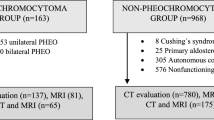Abstract
Objectives
To investigate the feasibility of using CT texture analysis (CTTA) to differentiate pheochromocytoma from lipid-poor adrenocortical adenoma (lp-ACA).
Methods
Ninety-eight pheochromocytomas and 66 lp-ACAs were included in this retrospective study. CTTA was performed on unenhanced and enhanced images. Receiver operating characteristic (ROC) analysis was performed, and the area under the ROC curve (AUC) was calculated for texture parameters that were significantly different for the objective. Diagnostic accuracies were evaluated using the cutoff values of texture parameters with the highest AUCs.
Results
Compared to lp-ACAs, pheochromocytomas had significantly higher mean gray-level intensity (Mean), entropy, and mean of positive pixels (MPP), but lower skewness and kurtosis on unenhanced images (P < 0.001). On enhanced images, these texture-quantifiers followed a similar trend where Mean, entropy, and MPP were higher, but skewness and kurtosis were lower in pheochromocytomas. Standard deviation (SD) was also significantly higher in pheochromocytomas on enhanced images. Mean and MPP quantified from no filtration on unenhanced CT images yielded the highest AUC of 0.86 ± 0.03 (95% CI 0.81–0.91) at a cutoff value of 34.0 for Mean and MPP, respectively (sensitivity = 79.6%, specificity = 83.3%, accuracy = 81.1%).
Conclusions
It was feasible to use CTTA to differentiate pheochromocytoma from lp-ACA.



Similar content being viewed by others
References
Korivi BR (2013) Cross-sectional imaging work-up of adrenal masses. World J Radiol 5:88. doi:10.4329/wjr.v5.i3.88
Bovio S, Cataldi A, Reimondo G, et al. (2006) Prevalence of adrenal incidentaloma in a contemporary computerized tomography series. J Endocrinol Invest 29:298–302. doi:10.1007/BF03344099
Lattin GE, Sturgill ED, Tujo CA, et al. (2014) From the radiologic pathology archives: adrenal tumors and tumor-like conditions in the adult: radiologic-pathologic correlation. Radiographics 34:805–829. doi:10.1148/rg.343130127
Johnson PT, Horton KM, Fishman EK (2009) Adrenal mass imaging with multidetector CT: pathologic conditions, pearls, and pitfalls. Radiographics 29:1333–1351. doi:10.1148/rg.295095027
Blake MA, Krishnamoorthy SK, Boland GW, et al. (2003) Low-density pheochromocytoma on CT: a Mimicker of adrenal adenoma. Am J Roentgenol 181:1663–1668. doi:10.2214/AJR.181.6.1811663
Patel J, Davenport MS, Cohan RH, Caoili EM (2013) Can established CT attenuation and washout criteria for adrenal adenoma accurately exclude pheochromocytoma? Am J Roentgenol 201:122–127. doi:10.2214/AJR.12.9620
Schieda N, Alrashed A, Flood TA, et al. (2016) Comparison of quantitative MRI and CT washout analysis for differentiation of adrenal pheochromocytoma from adrenal adenoma. Am J Roentgenol 206:1–8. doi:10.2214/AJR.15.15318
Allen BC, Francis IR (2015) Adrenal imaging and intervention. Radiol Clin North Am 53:1021–1035. doi:10.1016/j.rcl.2015.05.004
Zeiger MA, Thompson GB, Duh Q, et al. (2009) The american association of clinical endocrinologists and american association of endocrine surgeons medical guidelines for the management of adrenal incidentalomas. Endocr Pract 15(suppl 1):1–20. doi:10.4158/EP.15.S1.1
Young WF Jr (2007) Clinical practice: the incidentally discovered adrenal mass. N Engl J Med 356:601–610
Garrett RW, Nepute JC, El Hayek M, Albert SG (2016) Adrenal incidentalomas: clinical controversies and modified recommendations. Am J Roentgenol 206:1170–1178. doi:10.2214/AJR.15.15475
Hayano K, Tian F, Kambadakone AR, et al. (2015) Texture analysis of non-contrast-enhanced computed tomography for assessing angiogenesis and survival of soft tissue sarcoma. J Comput Assist Tomogr 39:607–612. doi:10.1097/RCT.0000000000000239
Tian F, Hayano K, Kambadakone AR, Sahani DV (2015) Response assessment to neoadjuvant therapy in soft tissue sarcomas: using CT texture analysis in comparison to tumor size, density, and perfusion. Abdom Imaging 40:1705–1712
Dang M, Lysack JT, Wu T, et al. (2015) MRI texture analysis predicts p53 status in head and neck squamous cell carcinoma. AJNR Am J Neuroradiol 36:166–170
Ganeshan B, Goh V, Mandeville HC, Hoskin PJ, Miles KA (2013) Non-small cell lung cancer: histopathologic correlates for texture. Radiology 266:326–336
Hodgdon T, Mcinnes MDF, Schieda N, et al. (2015) Can quantitative CT texture analysis be used to differentiate fat-poor renal angiomyolipoma from renal cell carcinoma on unenhanced CT images? Radiology 276:787–796
Lubner MG, Stabo N, Abel EJ, et al. (2016) CT textural analysis of large primary renal cell carcinomas: pretreatment tumor heterogeneity correlates with histologic findings and clinical outcomes. Am J Roentgenol 207:96–105. doi:10.2214/AJR.15.15451
Zhang GM, Sun H, Shi B, Jin ZY, Xue HD (2017) Quantitative CT texture analysis for evaluating histologic grade of urothelial carcinoma. Abdom Radiol (NY) 42:561–568. doi:10.1007/s00261-016-0897-2
Boland GW, Lee MJ, Gazelle GS, et al. (1998) Characterization of adrenal masses using unenhanced CT: an analysis of the CT literature. Am J Roentgenol 171:201–204
Miles KA, Ganeshan B, Hayball MP (2013) CT texture analysis using the filtration-histogram method: what do the measurements mean? Cancer Imaging 13:400–406. doi:10.1102/1470-7330.2013.9045
Davnall F, Yip CSP, Ljungqvist G, et al. (2012) Assessment of tumor heterogeneity: an emerging imaging tool for clinical practice? Insights Imaging 3:573–589. doi:10.1007/s13244-012-0196-6
Ng F, Ganeshan B, Kozarski R, Miles KA, Goh V (2013) Assessment of primary colorectal cancer heterogeneity by using whole-tumor texture analysis: contrast-enhanced CT texture as a biomarker of 5-year survival. Radiology 266:177–184
Acknowledgements
Z. Y. Jin has received research grants from the Ministry of Health in China.
Author information
Authors and Affiliations
Corresponding authors
Ethics declarations
Funding
This study was funded by the Health Industry Special Scientific Research Project of China (Grant No.: 201402019).
Conflict of interest
The authors declare that they have no conflict of interest.
Ethical approval
All procedures performed in studies involving human participants were in accordance with the ethical standards of the institutional and/or national research committee and with the 1964 Helsinki declaration and its later amendments or comparable ethical standards.
Informed consent
For this type of study, informed consent was waived by the institutional review board.
Rights and permissions
About this article
Cite this article
Zhang, GMY., Shi, B., Sun, H. et al. Differentiating pheochromocytoma from lipid-poor adrenocortical adenoma by CT texture analysis: feasibility study. Abdom Radiol 42, 2305–2313 (2017). https://doi.org/10.1007/s00261-017-1118-3
Published:
Issue Date:
DOI: https://doi.org/10.1007/s00261-017-1118-3




